Mystery snails are arguably one of the most beloved freshwater creatures in the fishkeeping community. Many people simply can’t get enough of these delightful invertebrates!
Not only are mystery snails aesthetically pleasing with their iridescent markings and cute ‘feet’, but they also play a vital role in keeping your aquarium clean.
These easy-to-care-for snails have a voracious appetite for various forms of algae and detritus. A tank of mystery snails can be a superb choice for a child’s first aquarium setup too.
However, it’s important to note that mystery snails (Pomacea bridgesii) are easily identified by their long, flowing tentacles to their diverse range of shell and body colors, so don’t get them mixed up with a possible nusance snail.
So, if you’re looking for an easy-to-care and visually appealing addition to your tank, consider adding some mystery snails to the mix. In this complete mystery snail care guide you’ll discover everyting you need to know about their food, tank size and setup, lifespan, what mystery snail eggs loook like and breeding tips plus much more!

At a Glance
| Min tank size: | 10 gal (40 l) |
| Temp: | 68-82°F (20-28°C) |
| Avg. lifespan: | 4 years |
| Adult size: | 2 inches (5 cm) |
| pH: | 7.5-8.5 |
| Diet: | herbivore |
| Behavior: | peaceful |
[toc]
Origins
Due to human interference, mystery snails can be found both in South and North America. In North America, they are known as invasive species.
There are also a few species that can be found in China as well. In the wild, these freshwater snails feed on dead and decaying plant matter and algae.
Color and Appearance

Mystery snails come in various colors: ivory, gold, black, magenta, and blue. Black and magenta-colored snails often have a striped pattern on the shell, while the others are solid.
The body of this species can have varying colors as well. The more common body colors are yellow and black, but blue or white bodies are also possible.
All of these snails also come equipped with a delightful, iridescent pattern on the body.
Newborn snails are as small as a grain of rice. They continually grow as they age and usually max out at around 2 inches (5 cm). Although sometimes, when in a perfect environment and fed a quality diet, they can reach up to 3 inches (7.6 cm).
Typically the lifespan of the mystery snail is about one year. But again, with outstanding care, they can reach the ripe old age of 2.
This snail has unique organs compared to other species. Mystery snails have gills and lungs, giving them extra access to oxygen when needed.
Though they have gills, their main source of oxygen is through actual air. When low on oxygen, the mystery snail travel to the water’s surface.
They will extend a long, tubular organ commonly referred to as their siphon. With the siphon extended, the snail sticks it out of the water and begins to rapidly move it back and forth, sucking in the air.
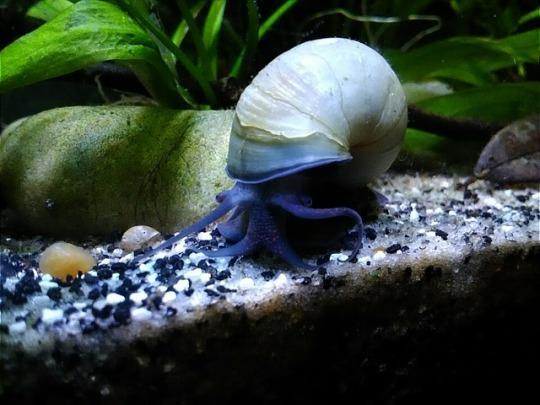
Mystery snails also have long sensory tentacles on the head that are usually about half the body length. These appendages help the snail feel around their environment in search of food.
It’s fun to watch them gently flowing with the current! Directly under the tentacles is a smaller set of eye stalks! And under the eyes is the mouth which has another set of tentacles to help with feeding.
Another attribute of the mystery snail is their operculum. The operculum is a hardened protective flap that seals the snail inside the shell.
When threatened or spooked, this snail will retreat into its shell and close its operculum. This seal provides ample protection from predators, perfectly sealing away the soft, delicate body.
Behavior and Tank Mates
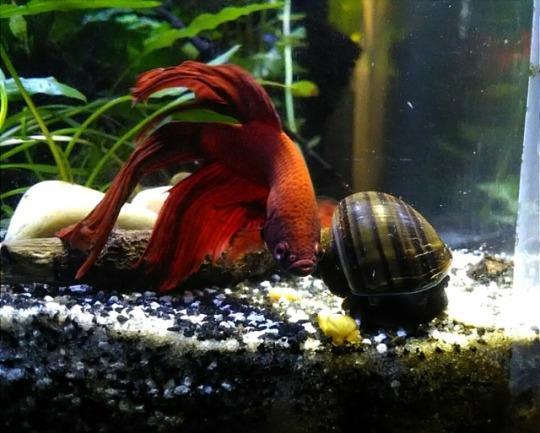
Pomacea bridgesii is a very peaceful species. They do great with other invertebrates and freshwater fish! The only fish they do not do well with are nippy or large fish.
The tentacles on a mystery snail are very sensitive and look rather worm-like. This makes them a prime target for aggressive and nippy fish. Although protected by their shell, large fish like goldfish and cichlids can still cause major damage. Therefore, mystery snails should never be housed with them.
Mystery snails spend the majority of their time slithering along the glass’ surface or on other hardscapes.
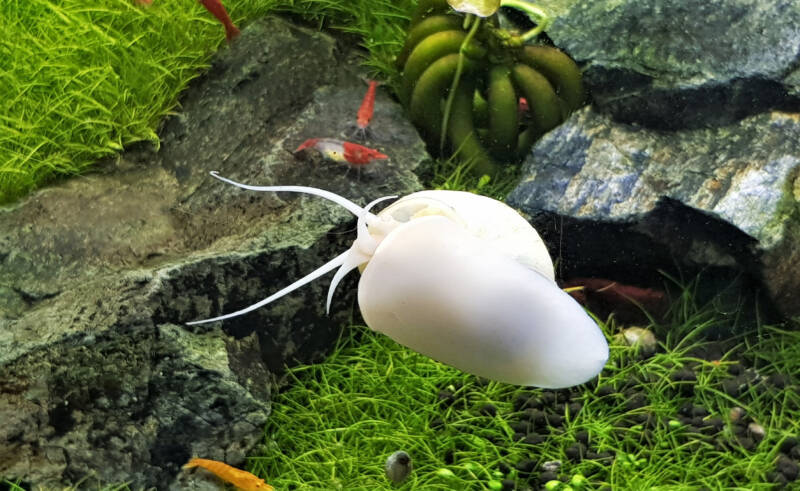
They also spend a lot of time at the bottom of the tank, foraging for food on the substrate. They use every inch of the aquarium!
Good tank mates for this species include, but are not limited to:
- Guppies
- Rasboras
- Corydoras
- Plecostomus
- Shrimp
- Other freshwater snail species
- Bettas – only if your betta is not aggressive. Some bettas like to attack the snail’s tentacles.
Pretty much any non-nuisance fish that is not too large does great with mystery snails! Just make sure that any cohabitants can comfortably reside in hard water, as these snails need it to keep their shells strong and healthy!
Tank Setup
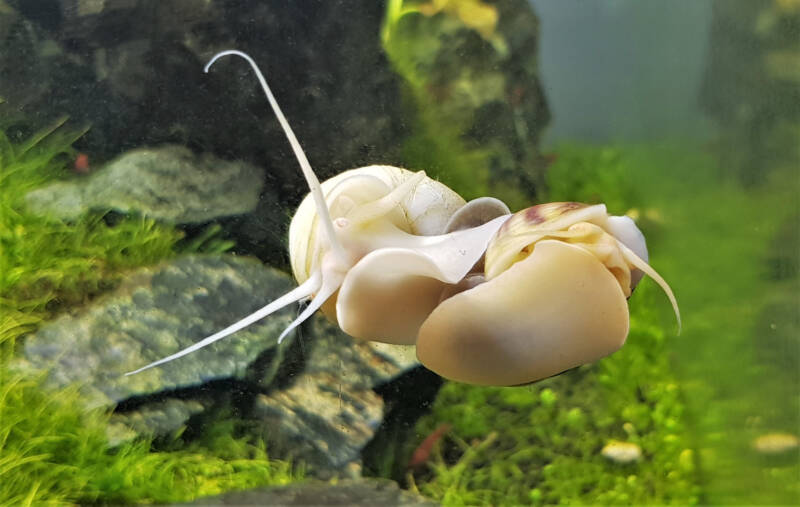
Setting up your new mystery snail tank can be just as fun as watching your snails slither about their new habitat! First things first, you’re going to need a tank!
The minimum tank size for this species is 10 gallons. Any less, and you risk fouling your water quality as these snails produce a lot of waste for their size.
Having a tank of at least 10 gallons ensures that your snail has access to stable water conditions and ample space. You can keep up to 2-3 mystery snails in a tank this size.
Once you’ve found your perfect tank you need to find a good filter. HOB (Hang on Back) filters, canister filters, and sponge filters are all good choices.
For this species though, since they release so much waste, HOB or canister filters are going to be your safest option. These types of filters use mechanical as well as biological filtration, providing you and your mystery snail with twice the filtration power.
Sponge filters will work as well, as long as you regularly use your gravel vacuum to suck up any feces and debris. Too much sitting debris can gunk up your water quickly!
As for water flow, mystery snails are not picky. They do well in both slow and fast-moving currents!
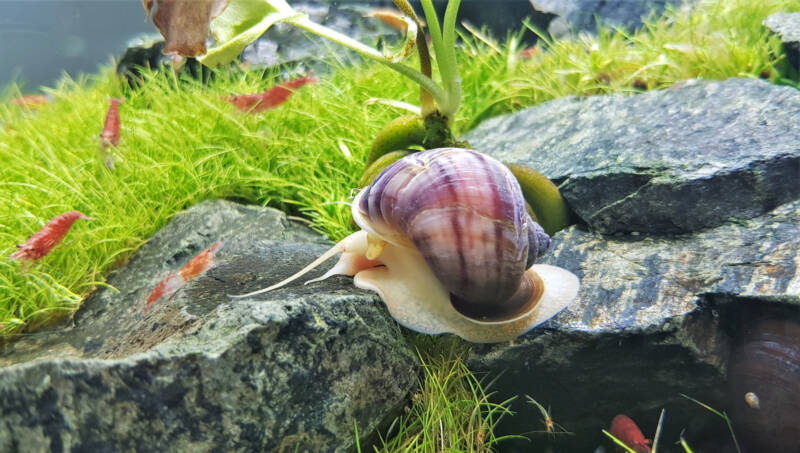
Next, you’re going to want to think about temperature. Mystery snails can withstand both lower and higher temperatures. Anything within 68-82°F (20-28°C) is safe for them.
If your house has a stable temperature of at least 68°F year-round, you may be able to get away with not having a heater.
On the other hand, since mystery snails and all other freshwater fish and invertebrates are not fond of sudden shifts in temperature, it would be best to acquire a heater regardless.
Play it safe – aim for a heater that puts out 5 watts per gallon. So for a 10-gallon tank, you’re going to want a 50-watt heater.
pH is a very important factor in keeping mystery snails. The shell of this species can begin to wear down and develop pitting if they’re being housed in water that has a too low pH. So, to keep these guys in tip-top shape, invest in a pH testing kit. Anywhere from 7.0 and up is tolerable.
Mystery snails enjoy having many surfaces to travel on. Adding rocks and driftwood to the tank makes for good enrichment!
These snails also like to hide from time to time, so providing rock caves, driftwood, and dense foliage can give them the cover to do just that!
Live plants are not as important with this species, though should be provided nonetheless. Broad-leaved plants such as swords and anubias not only provide a slithering surface but also provide a source of food.
Mystery snails do not eat live plants, don’t worry! They do, however, feed on dead and decaying plant matter! If your plants ever begin to lose leaves or rot, the mystery snail will help you clean up the mess!
The adequatesubstrate can be anything from soft sand to round gravel and rock. As long as the substrate is not rough and has no sharp edges it is safe to use in your mystery snail tank! The rough substrate can cause injury to the delicate foot of your snail. Keep it smooth, keep it safe!
Mystery snails have no specific lighting needs. They can do well at any brightness level.
Be aware, though, that sudden shifts in light can spook a mystery snail. But other than that, they will be fine with whatever light you give them.
Food & Snail Diet
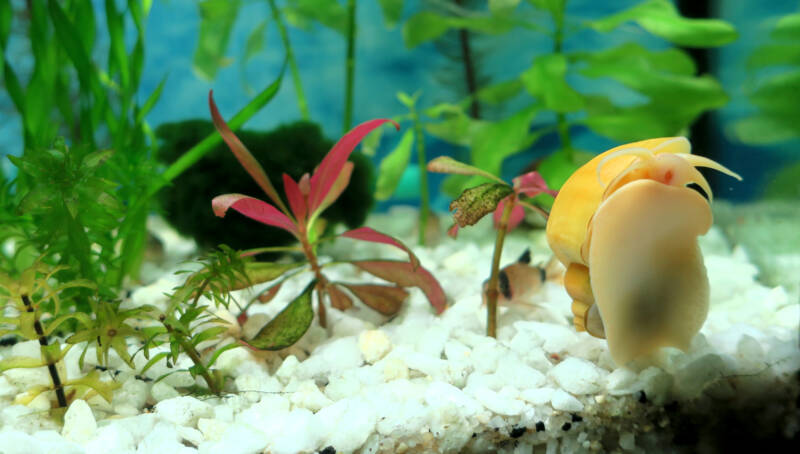
Mystery snails are herbivores, meaning they only eat plant material. In the wild, they feed on dead plants, algae, and other detritus.
They will eat this in the home aquarium as well, but the average aquarium usually does not have enough detritus to provide them with constant access to food. So, to keep your mystery snail fat and happy, you can feed them a few things:
- Blanched leafy greens – spinach, kale, collards, romaine lettuce
- Zucchini
- Broccoli
- Cucumber
- Algae and Veggie Wafers.
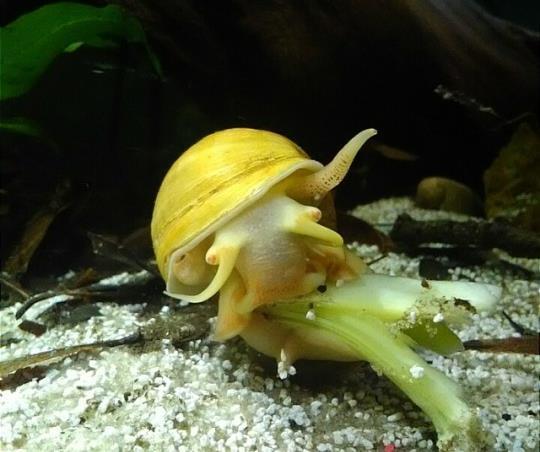
Mystery snails should be fed 2-3 times a week. Give them just enough at a time that they can finish within a day or two. Remove any uneaten food after that time, or it will begin to rot and may affect the water quality.
When fed enough, you should notice a slow, steady growth of your mystery snail. If you notice that you’ve had them for a while and they have not grown, it may be a sign that they are not being fed enough.
Sexing
Since all of these invertebrates’ organs are hidden inside the shell, it is quite difficult to tell the difference between the sexes.
The easiest way to tell is to catch a pair mating. The male will hold the female and insert his penis sheath into the shell of the female.
If you do not yet have a mating pair, there are some other, less obvious ways of telling them apart.
If you gently hold your mystery snail upside down, it will eventually come out of its shell to try and right itself. This will allow you to look inside the shell and see its organs.
In the male, the upper-left portion of the shell, behind the head, and in front of the gills, you will be able to visibly see the penis sheath. It may resemble a tube or just a lump of tissue depending on its position. Females will be missing this organ, and instead, have an open area in that spot.
Mystery Snail Eggs & Breeding
To induce breeding, all you need to do is get some males and females into a tank, the rest they handle on their own. Mystery snails follow the age-old adage of “they breed like rabbits” and need no intervention to get them started. However, I’d argue that mystery snails can reproduce at a significantly higher rate than rabbits! (just in case you need a fishkeeper joke).

When mating, the male holds the female in place with his foot. They can be on the glass, on the substrate, right-side up, or upside-down, mystery snails are versatile.
Once he has a good hold on the female, the male maneuvers his penis sheath, which closely resembles their siphon, into the genital aperture of the female. After he releases his sperm, the two separate and about their merry way. The female then holds the eggs until they are developed enough to be released.
Mystery snails lay their eggs above the water’s surface. They usually do this on the aquarium glass. This makes it very important to lower the water down a couple of inches to give the female room to lay her eggs.
If the eggs do not have access to open air, they will rot in the water and no longer be viable. The eggs will be laid in large clutches of up to 200!
When freshly laid, they are soft and have a light pink color, as they mature, they harden and become whiter. The snails will hatch after 2-3 weeks.
After hatching, the newborn mystery snails either fall into or slither back into the tank and immediately are in search of food. They can be fed all of the things that you feed your adults.
All this being said, some mystery snails will lay unfertilized eggs, even if she is a solo snail. Many times fishkeepers will have an escape snail situation as the snail moves out of the water to find the perfect place to glue her clutch. A common place mystery snails lay is on the sides of edge-mounted filters.
Disease

Since mystery snail is always hidden inside its shell, noticing, diagnosing, and treating illnesses is nearly impossible.
There are also no commercial medicines available to treat illnesses in snails. All you can do is do your best to avoid outside contaminants.
Try to avoid buying snails with damaged or cracked shells, this often weakens the immune system and can cause death.
It is best to also avoid buying snails from a tank with dead snails. Decaying snails quickly release ammonia and can cause great harm to any live snails in the same tank.
Properly acclimate your snails when adding them to their new tank. You need to transition them to the chemicals in your water as well as the temperature.
Soak whatever container they came in your tank. Every 10 to 15 minutes, add a small amount of the tank water into their current container. Do this for 45 minutes to an hour.
By the end of this process, the water in their holding container will gradually become the same as what’s in the tank. This slowly gets the snail used to their new water, giving them an easy transition and a much better chance of survival.
Now, to tell the difference between a healthy and sick snail, take note of their behavior.
Healthy mystery snails are active. They are constantly moving, feeding, and spending time outside of their shell. Sick individuals are not so active.
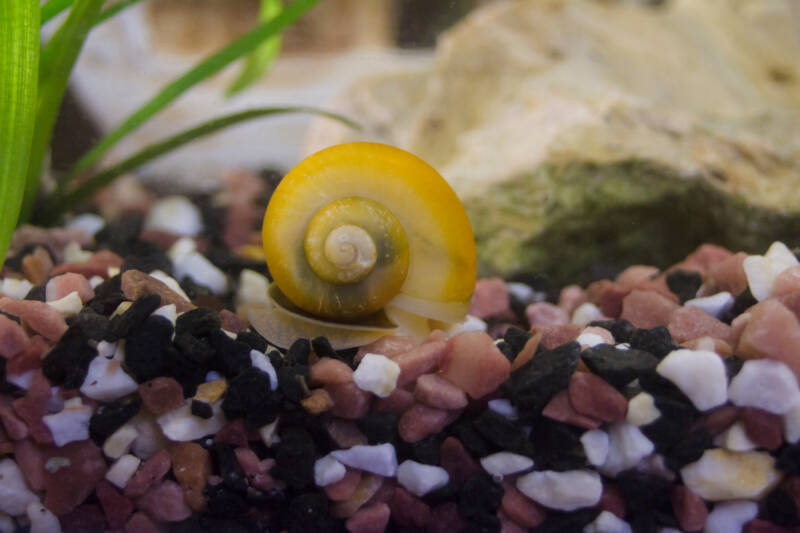
An unhealthy snail will hide in one spot all day, spending most, if not all, of its time stashed away inside its shell.
Sick snails may also float at the top of the tank longer than usual.
The last way to spot an unhealthy snail is by looking at its foot. When irritated or uncomfortable, mystery snails can excrete a mucous-like slime that protects the vulnerable body.
This mucus is visible even in a closed-up snail, as some usually spills out of the operculum. If you notice any of these occurrences in your mystery snail, there’s a good chance it’s not feeling well.
What to do when your snail is sick
Once sick, there is not much you can do to try and heal your snail. All you can do is keep the water clean with no ammonia, nitrites, or nitrates.
If the snail is not too sick, it will get better on its own. If it doesn’t recover, here’s how you can tell whether or not it’s alive.
Probably the easiest, and grossest, way to tell if your mystery snail is still alive is by smelling it. Dead snails begin to smell very soon after death. If it smells rotten, it has passed and should be removed from the tank immediately.
If your mystery snail is still inactive but has no smell, it is still alive. Put it back in the tank, operculum side down, and wait to see if it recovers.
Another way to tell if your snail is still alive is by touching its foot. A live snail will always contract at your touch, dead snails, of course, do not move.
There is also a noticeable difference in the texture of the dead tissue. Live mystery snails are very soft and squishy, but once dead, they feel a little tougher.
Closing Thoughts
Mystery snails are a long-time favorite invertebrate in the hobby. Their interesting behavior and vivid shell colors brighten up any freshwater aquarium.
Their peacefulness and adaptability make them perfect for community aquariums, but a species-only tank can be just as exciting!
Have any questions, comments, or concerns? Leave them below!

